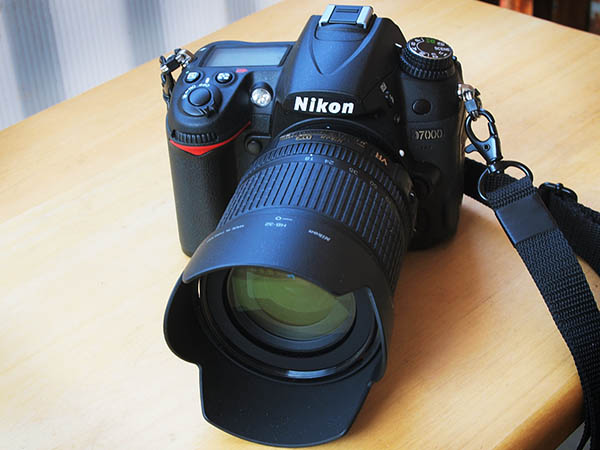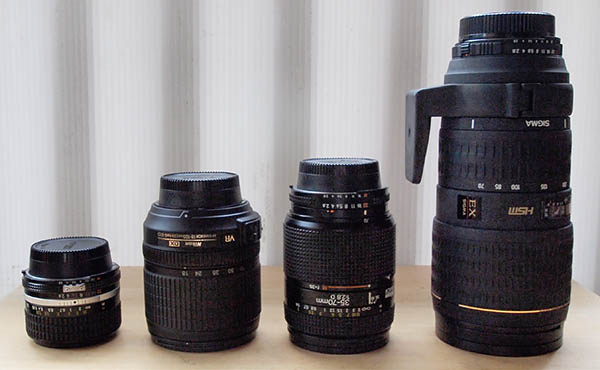Nikon D7000, an eclectic's user report
Page 1 of 3. Version 1.1, ©2011 by Dale Cotton, all rights reserved.

Fig. 1: D7000 + 18-105 kit zoom
My slant: I shot with Nikon film SLRs for years, then Pentax dSLRs for several years. Purchasing the D7000 is my first experience with a Nikon dSLR, which at least gives me a rather different perspective than that of the usual reviewer. My photographic background is in the microcosms of landscape and candids/street, all done using existing light. I have no experience whatsoever with sports or wildlife or studio or flash or video and will not attempt to evaluate the D7000 in those regards. Finally: I always shoot raw and post process as needed but use JPEG extensively for on-line work like this.
Warning! Photo-Geek spoken here!: Nikon officially classifies the D7000 as a pro camera, so I'm not going to shy away from technical issues. If a section makes your head hurt, skip over and read on. I'm sure the gist will come through.
Why buy an APS-C dSLR?
One of the commonest clichés in photography is that the best camera is the one you have with you. The ultimate best camera would have the image quality (IQ) of an 80 MP Phase One, the frame rate and high ISO capability of a Nikon D3s, a fixed 16-500 f/1.0 zoom, and fit in your shirt pocket like a Canon S95. Sadly, there is no indication such a camera is headed to market as I write this. The question the various manufacturers ask you is: what compromise are you willing to accept?
One solution would be to buy the camera and lenses with the very best image quality you can afford (perhaps a full frame dSLR) and take that out the door whenever you know you'll actually be shooting, then carry a pocket cam all the rest of the time. One problem with that is a full frame dSLR plus one or more pro-grade lenses is too much weight to carry on an all-day hiking or tourist excursion. Another is the sheer price. Yet another is that the IQ of the pocket cam – or lack of an essential feature like decent high ISO or a long enough focal length – can be a hard pill to swallow. So the pocket cam may indeed get out the door but rarely get out of the pocket.
Another solution would be to own just one camera but make it one that's light enough in weight that carrying it around all day is not a ticket to the chiropractor's. Many people feel that any SLR would fail that test and so look to the new product category of mirrorless. Then they complain endlessly about the pokey AF and/or compromised view finder and/or mediocre IQ of their chosen mirrorless. While they're complaining they buy an increasing number of cute little lenses and lug them around ... then soon find their camera bag has become so hefty that it's no longer a no-brainer whether it goes out the door.
Yet there was once an era in the history of photography when none of this was an issue. Back then you bought a 35mm camera body, stuck the 50mm kit lens on the front, stuck that combo in a form-fitting case with shoulder strap, and slung that over your shoulder. Total weight: slightly less than 2 lbs (1 kg). Strangely, that's the same weight as a D7000 + kit 18-105 (or D7000 + 18-200 or D7000 + two primes). An alternative would be to buy a D5100 or D3100 and their kit lenses. (This involves accepting a cluster of compromises like a smaller, dimmer finder and a more limited control set, but the 5100 uses the same sensor as the D7000, and the D3100's sensor is no slouch, either.)

Fig. 2: Then and now: 50mm + holster bag + Nikon FM vs.18-105 + holster bag + D7000
The upshot is: buy a good APS-C dSLR + one good but light lens, put that in a shoulder bag, then take it with you whenever you go out the door. Problem solved. ;)
So the question becomes: is the D7000 a good enough camera body for your needs and is the default 18-105 a good enough lens for your needs? Let's get the second half of that question out of the way first...
Lenses

Fig. 3: A random sampling of Nikon and Nikon-compatible lenses (28, 18-105, 35-70, 70-200)
The fact that the 18-105 is a G-designated kit 3.5 to 5.6 does not lend one to confidence. If bokeh and speed are essential to how you do photography you'd most likely give it's 3.5-5.6 a pass. If long tele is essential to what you do, ditto. But for everything else I've tested the begeezus out of it and to my utter amazement have been blown away at every turn. I have a pricey Nikkor 35-70 f/2.8 from my film days that I was planning to use for landscape work in spite the crop factor robbing me of its wide end. Now, many regard that 35-70 as one of the very sharpest moderate lenses – prime or zoom – Nikon ever created; but all it gives me is maybe a one or two percent improvement in detail over the 18-105 across the 35-70 range, and surprisingly at least a stop less transmittance. I also have a 28mm f/2.8 AIS Nikkor prime. The 18-105 runs circles around it.
Not only is the 18-105 sharp, it has virtually no corner distortion except at the widest focals, and there it's as good as anything I've seen. It's AF isn't quite as fast as the pro glass, but it's not pokey either. Plus, the combination of 18-105 on D7000 has just the right heft and perfect balance to my tastes. Add that to the equivalent 27.5-157.5mm coverage and, frankly, I can't see why I'd ever take it off the front of my camera. As a spot-meter user, being able to zoom out to 3x mag to take a reading is very nice.
But my needs aren't your needs. Here's a beautiful tool for finding the right lens: The-Digital-Picture.com lens comparison tool.
Caveat: Another photographic cliché is to choose a camera system based on the extent of its lens selection, and Nikon has a huge selection to choose from. Only problem with that statement is that it's more true if you shoot 35mm or digital FF (full frame) than if you shoot DX (APS-C). Nikon's DX options are less than exhaustive, particularly at high-end wide angle. So double-check before blindly assuming Nikon makes everything they need.